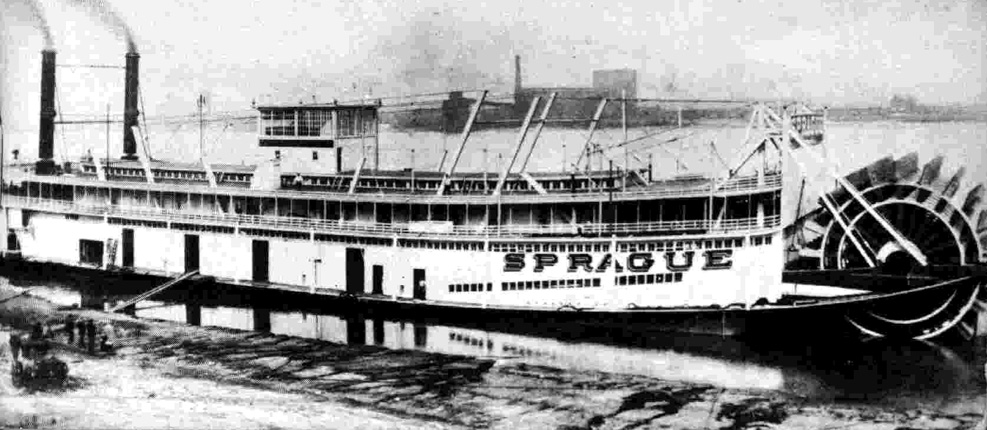Encyclopedia Dubuque
"Encyclopedia Dubuque is the online authority for all things Dubuque, written by the people who know the city best.”
Marshall Cohen—researcher and producer, CNN
Affiliated with the Local History Network of the State Historical Society of Iowa, and the Iowa Museum Association.
SPRAGUE: Difference between revisions
No edit summary |
No edit summary |
||
| Line 1: | Line 1: | ||
[[Image:sprague.JPG|left|thumb|350px|Largest stern-wheel vessel of her type in the world in 1902.]]SPRAGUE. Largest and most famous of the | [[Image:sprague.JPG|left|thumb|350px|Largest stern-wheel vessel of her type in the world in 1902.]]SPRAGUE. Largest and most famous of the [[MISSISSIPPI RIVER]] paddle wheel steamers. Manufactured in 1901 by the [[DUBUQUE BOAT AND BOILER WORKS]], the 318-foot ''Sprague'' was often called "Big Mama." Hr hull measured 276 feet in lengthy by 61 feet in width. The paddle wheel was 38 feet in diameter and 40 feet wide with 21 buckets (a river term for paddles). One of the first boats of its kind to push rather than pull its cargo, the ''Sprague'', with its 160-ton paddlewheel, was capable of moving 67,307 tons at a time. In February 1907 hitched to 56 coal boats and 4 barges, she set a record, The cargo of 67,307 tons of coal was the greatest cargo every handled in marine history in a single movement. The barges covered an area equivalent to 6.5 acres. In 1926 the ''Sprague''moved eleven million gallons of oil. Beginning in 1925 she was operated by Standard Oil of New Jersey on the lower Mississippi. | ||
Before being' retired to Vicksburg, Mississippi, as a restaurant, museum, and theater boat, the Sprague operated on the rivers of the Midwest for fifty years. When the Sprague's towboat career ended in 1948, the city of Vicksburg bought the boat from its owners for one dollar. In its service around Vicksburg, the Sprague attracted more than twenty thousand tourists annually. | Before being' retired to Vicksburg, Mississippi, as a restaurant, museum, and theater boat, the Sprague operated on the rivers of the Midwest for fifty years. When the Sprague's towboat career ended in 1948, the city of Vicksburg bought the boat from its owners for one dollar. In its service around Vicksburg, the Sprague attracted more than twenty thousand tourists annually. | ||
Revision as of 02:27, 26 January 2009
SPRAGUE. Largest and most famous of the MISSISSIPPI RIVER paddle wheel steamers. Manufactured in 1901 by the DUBUQUE BOAT AND BOILER WORKS, the 318-foot Sprague was often called "Big Mama." Hr hull measured 276 feet in lengthy by 61 feet in width. The paddle wheel was 38 feet in diameter and 40 feet wide with 21 buckets (a river term for paddles). One of the first boats of its kind to push rather than pull its cargo, the Sprague, with its 160-ton paddlewheel, was capable of moving 67,307 tons at a time. In February 1907 hitched to 56 coal boats and 4 barges, she set a record, The cargo of 67,307 tons of coal was the greatest cargo every handled in marine history in a single movement. The barges covered an area equivalent to 6.5 acres. In 1926 the Spraguemoved eleven million gallons of oil. Beginning in 1925 she was operated by Standard Oil of New Jersey on the lower Mississippi.
Before being' retired to Vicksburg, Mississippi, as a restaurant, museum, and theater boat, the Sprague operated on the rivers of the Midwest for fifty years. When the Sprague's towboat career ended in 1948, the city of Vicksburg bought the boat from its owners for one dollar. In its service around Vicksburg, the Sprague attracted more than twenty thousand tourists annually.
In 1974 a fire gutted the boat without damaging the paddlewheel. In 1979 the once mighty boat sank in the mud of the Yazoo River and split in half.


